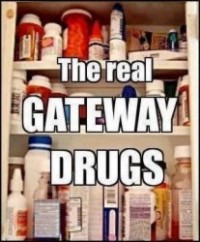Gateway Drugs

The real gateway drug is not marijuana: We
have all heard that marijuana is the gateway drug. Some political
leaders and anti-drug groups often make this claim. They try to
convince the public that 99 percent of illicit drug users tried
marijuana before they did other drugs. Sounds so convincing even
though they have no evidence to back up their claims.
On the other hand, a study in 2016 has shown by the Journal
of School Health, that a team of researchers from Texas A&M and the
University of Florida examined data from 2,800 U.S. 12th graders
that were interviewed for an annual federal survey on teen drug
abuse. The goal of the survey was to establish what substances teens
typically used first.
They found that the vast majority of those who responded to
the survey reported using alcohol, prior to tobacco and marijuana.
Out of the three main substances asked about in the survey, the
teens were least likely to start using pot before the others. The
first drug used by 54% of the teens was alcohol, followed by tobacco
at 32%, and marijuana came in last at only 14%.
Studies have also shown that 6th or 7th graders who had
their first drink at this age went on to try an average of nearly
two illicit substances later. However, those who waited till the
12th grade to drink had only tried an average of 0.4 substances.
According to surveys, close to 90% of all Americans over the age of
18 report they have consumed alcohol at least once, and over 60% of
individuals aged 18 years and older admit to at least one
binge-drinking session in the past month.
Keep in mind that over 88,000 people die from
alcohol-related incidents each year in the U.S., making
alcohol-related incidents the third leading cause of preventable
death in this nation alone. Tobacco use is second to alcohol when it
comes to gateway drugs. Scientist have long recognized that
cigarettes and alcohol raise the risk for later use of illicit drugs
like marijuana and cocaine. In a survey back in 2011, over 90% of
adult cocaine users between the ages of 18 and 34 had smoked
cigarettes before they began using cocaine. Researchers suspect that
nicotine exposure might increase vulnerability to cocaine.
What about legal painkillers? In October 2016, Attorney
General Loretta Lynch spoke to a bunch of Kentucky high school
students about heroin abuse. Lynch said that prescription drug abuse
is the biggest gateway to the use of hard drugs. Whereas, cannabis
has proven not to be a main gateway. The household medicine cabinet
is the main source of abuse Lynch said. But, it's not likely we're
seeing that marijuana as a specific gateway.
Prescription pills, such as Vicodin, hydrocodone, morphine,
and oxycodone have become highly addictive. These prescription pills
are legal and are also easy to find on the street, and have
different effects. These pain killers remove the feeling of pain and
sedate the user. However, when their supply is cut off, prescription
drug users tend to turn to illegal drug markets for the same
effects. Many of these drug users skip right over marijuana and turn
to hard opioids such as heroin. Marijuana has been known to be an
exit drug to many heroin, fentanyl,
opioid, and cocaine users. We need
to make the public aware that marijuana is not the culprit, but
rather the solution to many medical conditions and safe casual use
to recreational enjoyment.
Peace
Disclaimer: All the information on this website is published in good faith and for general information purpose only. cannabiscounty1.com does not make any warranties about the completeness, reliability and accuracy of this information. Any action you take upon the information you find on this website (cannabiscounty1.com), is strictly at your own risk. cannabiscounty1.com will not be liable for any losses and/or damages in connection with the use of our website.




